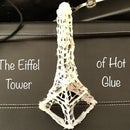Introduction: Auto-Adjusting Bow and Arrows
What exactly is an auto-adjusting bow? Well, it's a type of bow I invented. It’s basically a bow that can use many different sized arrows. Depending on the size of the arrow, the bow automatically adjusts the tension in the bowstring. This is not to be confused with a compound bow.
The auto-adjusting bow is run by two axels. When the bowstring is drawn to a certain point, the axels rotate and reduce the tension by increasing the rubber band length between the two ends of the limbs. The bow can adjust to fire a large variety of arrow lengths, which differs depending on the rubber band strength.
Attachments
Supplies
6 Large popsicle sticks (15cm X 2cm)
5 small popsicle sticks (11.25cm X 0.75cm)
4 bottle caps
1 large rubber band
2 popsicle sticks
Hot glue gun
Step 1: Riser and Limbs
We will start by building the riser limbs of the bow. First, glue three large popsicle sticks, each at a 135° angle from the stick in the middle. The two ends of the limbs should be perpendicular to each other. Make two of these. Next, on the side with the center popsicle stick on top, use two small popsicle sticks to support the limbs. Repeat this on the other limb.
Step 2: Connecting the Halves
Use a drill or box cutter to cut holes in the ends of the four limbs and the four bottle caps (these will be used later).
Next, cut the small popsicle stick into three 1cm pieces. Hot glue the 1cm edge on one half of the riser and limbs. One should be in the middle. This will act as the arrow rest. The other two should be at the ends of the limbs. Apply glue to the tops of these pieces and place the second half of the riser and limbs on top. Make sure the side of the halves with the small popsicle stick supports is facing inward.
Step 3: The Axels
It's time to build the axels. Remember that the axels must be able to spin easily. I CANNOT STRESS THIS ENOUGH!!!. If the axels don't spin easily, the bow will not be able to adjust the tension of the bowstring. First, cut each toothpick in half. Feed two of the halves into the holes that were cut in the ends of the limbs. Then add a bottle cap to each side. The top of the bottle cap (the side that would be facing upward if it was on a bottle) should face the limbs. Hot glue these bottle caps in place. Do not glue them too close to the limbs or they will create friction and stop the wheel from spinning.
Step 4: The Bowstring
Take the large rubber band and cut it, creating one long rubber string. Tie each end to a toothpick half. You may need to hot glue them in order to keep them from untying. Glue one to a limb, closer to the riser than the axel. Next feed the string around the opposite axel (axel 2), entering on the side facing the riser and exiting on the side facing the archer. Feed it around the axel on the limb where the beginning of the string is (axel 1), entering on the side facing the archer and exiting on the side facing the riser. Feed this to the opposite limb and glue it on the outside of the limb, closer to the riser than the axel. Refer to the diagram.
Step 5: Building the Arrows
I made three different size arrows, but you make as many or few as you want.
For the smallest arrow, I used a chopstick.
For the medium arrow, I used a skewer. Using a hot glue gun, I made the nock, which is basically a U shaped piece that clings onto the string while it is being drawn. The nock was made by gluing a glob onto the end of the arrow and pressing a toothpick onto the middle of it. In the same fashion, an arrowhead was made so that the front would be heavier.
For the largest arrow, I used a skewer and a chopstick. I glued them together and secured them with toothpicks and a rubber band. The nock was also made out of glue.
Step 6: Draw, Aim, and Fire!!!
Your auto-adjusting bow is ready to use! This is also the time for troubleshooting, if the nock of the arrow is too large, it may not fire correctly. In addition, you may need to rebuild the axels if they do not spin.
The range of the bow differs greatly depending on the rubber band strength and arrow length. Generally, stronger rubber bands (obviously) and longer arrows will increase the range.
Once you're finished, have fun with your bow! Just don't point it at anyone's eyes (or anyone at all).

Participated in the
Rubber Band Speed Challenge












